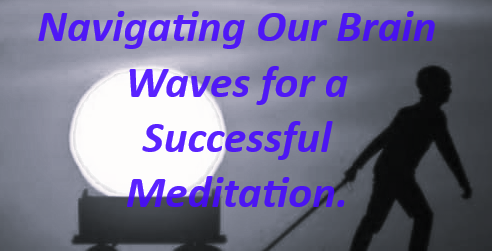Navigating Our Brain Waves for a Successful Meditation.

Navigating Our Brain Waves for a Successful Meditation.
If meditation is about entering the autonomic system so that we can become more suggestible and overcome the challenges just mentioned, then we need to know how to get there.
The short answer is that we get there on a brain wave.
The brain state we happen to be in at any given time has a huge effect on how suggestible we are at that moment.
Once you learn what these different states are and how to recognize them when you’re in them, you can train yourself to move from one state to another, up and down the scale of brain-wave patterns.
It takes some practice, of course, but it is possible.
So, let’s explore these different states to learn more about them.
When neurons fire together, they exchange charged elements that then produce electromagnetic fields, and these fields are what are measured during a brain scan (like an electroencephalograph, or EEG).
Humans have several measurable brain-wave frequencies, and the slower the brain-wave state we’re in, the deeper we go into the inner world of the subconscious mind.
In order of slowest to fastest, the brain-wave states are;
- delta (deep, restorative sleep totally unconscious),
- theta (a twilight state between deep sleep and wakefulness),
- alpha (the creative, imaginative state),
- beta (conscious thought),
- gamma (elevated states of consciousness).
Beta brain-wave
Beta is our everyday waking state.
When we’re in beta, the thinking brain, or neocortex, is processing all of the incoming sensory data and creating meaning between our outer and inner worlds.
Beta isn’t the best state for meditation, because when we’re in beta, the outer world appears more real than the inner world.
Three levels of brain-wave patterns make up the beta-wave spectrum:
- low-range beta (relaxed, interested attention, like reading a book),
- mid-range beta (focused attention on an ongoing stimulus outside the body, like learning and then remembering),
- high-range beta (highly focused, crisis-mode attention, when stress chemicals are produced).
The higher the beta brain waves, the further away we get from being able to access the operating system.
Alpha brain-wave.
Most days, we move back and forth between beta and alpha states.
Alpha is our relaxation state, where we pay less attention to the outer world and start to pay more attention to our inner world.
When we’re in alpha, we’re in a light state of meditation; you could also call that imagination or daydreaming.
In this state, our inner world is more real than our outer world, because that’s what we’re paying attention to.
When we go from high-frequency beta to slower alpha, where we can pay attention, concentrate, and focus in a more relaxed manner, we automatically activate the frontal lobe.
As the previous material has presented, the frontal lobe lowers the volume of the brain circuits that process time and space.
Here, we’re no longer in survival mode.
We’re in a more creative state that makes us more suggestible than we were in beta.
Theta brain-wave.
More challenging is learning how to drop down even further into theta, which is a kind of twilight state where we’re half-awake and half-asleep (often described as “mind awake, body asleep”).
This is the state we’re shooting for in meditation because it’s the brain-wave pattern where we’re the most suggestible.
In theta, we can access the subconscious, because the analytical mind isn’t operating and we’re mostly in our inner world.
Think of theta as the key to your subconscious kingdom.
You’ll find this brief tour through brain-wave patterns even more useful when you get to the practice of meditation.
Don’t expect that you’ll necessarily be able to drop right into theta on command, of course, but having some knowledge of what the various brain states are and what effect they have on what you’re trying to achieve will help.
Gamma brain wave.
Gamma brain-wave patterns are included because they represent a level of super-awareness, which reflects a heightened state of consciousness.
Join Enlighten Knowledge WhatsApp platform.
Join Enlighten Knowledge Telegram platform.








